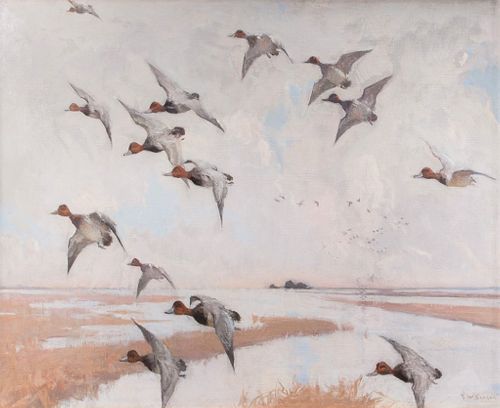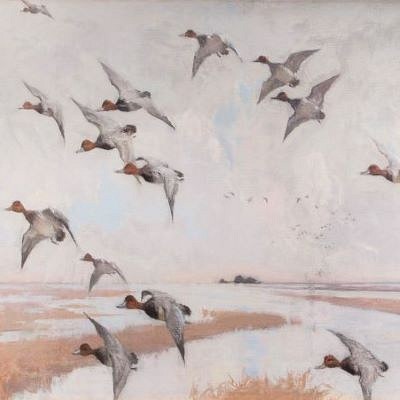Frank W. Benson (1862-1951) Redheads in Flight
About Seller
20 Winter Street
Pembroke, MA 02359
United States
Founded in 2005, Copley Fine Art Auctions is a boutique auction house specializing in antique decoys and American, sporting, and wildlife paintings. Over the course of the last two decades, the firm has set auction records for not only individual decoy makers, but also entire carving regions. Copley...Read more
Two ways to bid:
- Leave a max absentee bid and the platform will bid on your behalf up to your maximum bid during the live auction.
- Bid live during the auction and your bids will be submitted real-time to the auctioneer.
Bid Increments
| Price | Bid Increment |
|---|---|
| $0 | $50 |
| $1,000 | $100 |
| $2,500 | $250 |
| $5,000 | $500 |
| $10,000 | $1,000 |
| $25,000 | $2,500 |
| $50,000 | $5,000 |
About Auction
Feb 19, 2021
Lots 1-292 Copley Fine Art Auctions cinnie@copleyart.com
- Lot Description
Frank W. Benson (1862-1951)
Redheads in Flight, 1916
signed and dated "F.W. Benson '16" lower right
oil on canvas, 36 1/4 by 45 in.
Frank Benson spent his boyhood hunting and fishing on the Essex County marshes near his Salem, Massachusetts, home. He was fascinated by ornithology and a great admirer of John James Audubon, often spending hours visiting the Museum of Comparative Zoology at Harvard.
When he entered the School of the Museum of Fine Arts in Boston, Benson's goal was to be an ornithological illustrator. His first known oils are of a rail and a snipe. However, two years of study at the Academie Julian in Paris changed his mind. When Benson returned to Boston, he built his career on finely crafted portraits and stunning interiors of models lit by the glow of a fire or the shimmer of lamplight. Yet he never forgot his first love, the birds that filled the air and the waters of his New England home. His earliest known exhibited painting of wildfowl was "Swan Flight," a large canvas depicting the decorative effect of white swans sweeping across a wide expanse of pearl gray sky. By the time it was seen in the galleries of Boston's St. Botolph Club in 1894, it had already been bought by Dr. Arthur Cabot, a close friend and fellow hunter.
Such early oils of wildfowl are rare. For the next two decades, Benson only exhibited four paintings of birds.(i) This is not surprising. During those years, as co-director of Boston's Museum School, Benson began creating his stunning wash drawings of wildfowl and started producing the many etchings and drypoints that won him great fame and earned him the title, "Dean of the American Sporting Print." In addition, his sunlit, Impressionist paintings of his daughters posed against the summer skies of his island home in Maine were in such demand that they sold as quickly as they were finished.
By 1916 Benson's children, whom he called his "homegrown models," were growing up and leaving home. That fall, he accompanied Arthur Cabot to Cabot's private hunting club on the shores of Lake Erie. It was a trip that would deeply affect his painting for years to come and was, in all likelihood, the setting for "Redheads in Flight." It is probably not coincidental that Benson chose to commemorate his first trip to Long Point with this masterful painting of the birds that surrounded him there. The island in the background of this oil adds a striking note to the work. It is a compositional device that Benson employed in a number of his etchings set at Long Point, such as "Over Sunk Marsh" and "Sunset at Long Point," as well as in at least one oil, "Long Point Sunset," 1923 and several watercolors.(ii)
Formally called The Long Point Company, the club, a collection of buildings elevated about four feet above the water on pilings and connected by a network of boardwalks, was founded on a broad peninsula of land by a group of Canadian businessmen in l866. The express purpose of the club was to keep their favorite hunting ground from being depleted by almost year-round hunting. "The Point looks like a Florida mangrove Key," Benson wrote in his hunting diary. "Just a few trees that appear to be growing out of the lake." Eager to get in a bit of shooting his first day there, Benson recalled, "We set decoys hurriedly as it was late, and the ducks came often but not quite near enough. I shot down twenty one and retrieved fifteen. . . The prettiest afternoon's shooting I ever had."(iii)
It is clear from Benson's diaries that his experiences at Long Point were some of his most treasured memories. In letters home and in interviews, Benson frequently mentioned the beauty of the land and the excellence of the shooting. From the sheer overwhelming numbers of the birds that he saw, it appears that nothing surpassed those hunting grounds. "I saw such a sight today as I never expect to see again," Benson wrote. "When we started out, ducks rose in thousands and thousands all over the marsh and the whole sky was covered. . . . Thousands of Redheads and Canvasbacks were coming in from the North in lines and V's high up against the sky all the morning . . . the noise was like thunder"(iv) It was undoubtedly a scene such as this that inspired "Redheads in Flight." The viewer feels that he is not so much observing the painting as he is in it. One can almost feel the rush of the ducks wings and hear their calls.
Ornithologist Roger Tory Peterson praised Benson as a painter of bird "pictures," paintings that focused on the birds' world, while noting that Audubon, who killed his subjects and wired them into position, was more a painter of bird "portraits." Yet, like an ornithologist, Benson was careful to depict both male and female in various attitudes of flight. In "Redheads in Flight," the ducks are what command immediate attention, yet the work also focuses on composition, light, and design, elements that Benson felt were critical in any painting.
As a contemporary writer wrote, "Frank W. Benson has added something imperishable--an artist's dream [that Audubon] knew not; a knowledge of bird flight which places him in a class by himself."(v) Decades of observing birds permitted Benson to portray them in flight or at rest not only accurately, but also with grace and fluidity. As Benson once told a writer, "I try to make them part of the landscape in which they occur, rather than to describe them as specimens. What I most enjoy about them is their wildness." Noting that birds rarely pose for a picture, he said, "My pictures of wild-fowl are entirely the result of things seen in nature and drawn from memory."(vi)
"Redheads in Flight" clearly evoked for Benson the wonderful memories he had of his days at Long Point both shooting and painting. "Long Point was a wonderful place to me for I never had such a chance to see so many kinds of ducks so close at hand," Benson once wrote to a collector. "I passed one whole day watching every duck that came to my decoys to see how he used his legs when dropping, recovering, rising, et. cetera and, instead of making the best of the shooting, I had a very profitable day in another way."(vii)
--------------------
We are grateful to Faith Andrews Bedford, author of the biography "Frank W. Benson: American Impressionist," "The Sporting Art of Frank Benson," and "Impressionist Summers: Frank W. Benson's North Haven," for this essay.
Endnotes:
i It is very likely that a few others were sold out of his studio for, as he wrote to a dealer who wanted such a work, "If I choose to be patient I can sell them all in Boston. If I make one with figure or birds, it is commonly sold as soon as it is framed, and often before." In closing he added, "if I were to create any larger demand, I simply couldn't fill it." Frank W. Benson to Robert Macbeth. 22 February 1926, Macbeth Gallery Papers, Archives of American Art, Smithsonian Museum.
ii At least seven prints have titles that locate their setting as Long Point. For a discussion of the oil painting "Long Point Sunset" and the related etching, see Faith Andrews Bedford's essay "Frank W. Benson's Paintings and Prints: Inspiration and Replication" in John Ordeman's book "Frank W. Benson's Etchings, Drypoints, Lithographs and Prints," Lydia Inglett Publishing, Hilton Head, S.C., 2012.
iii Benson, Frank W. Benson. Hunting Diary, 8-9 October 1916. Frank W. Benson Papers, Peabody Essex Museum. As quoted in Faith Andrews Bedford's "The Sporting Art of Frank W. Benson," Boston, David R. Godine, 2000.
iv Ibid., 25 October 1920.
v Arthur Philpott, unidentified newspaper clipping, November l936, Artist's Scrapbook, Benson Papers, Peabody Essex Museum. As quoted in Faith Andrews Bedford's "The Sporting Art of Frank W. Benson," Boston, David R. Godine, 2000.
vi Lumsden. E.S. "The Art of Etching," p. 328. J. D. Lippincott, Philadelphia. 1924. As quoted in Faith Andrews Bedford's "The Sporting Art of Frank W. Benson," Boston, David R. Godine, 2000.
vii Frank W. Benson to Mr. Band, n.d. Benson Papers.
Redheads in Flight was acquired by Mr. Allen, who purchased Benson's summer home, Wooster Farm in North Haven, Maine in 2013. Allen's grandfather, Frederick Warren Allen, was an assistant to sculptor Bela Pratt and first came to North Haven in 1913. Allen now keeps Wooster Farm as "an open, living museum...a living and breathing tribute to Frank Benson."
Provenance: Private Collection, Boxford, Massachusetts, until 1970
Vose Galleries of Boston, inventory no. 23231
Private Collection, Cambridge, Massachusetts, 1970
Private Collection, Chestnut Hill, Massachusetts
Private Collection, California
Peter Allen Collection, acquired from Copley Fine Art Auctions, Plymouth, MA, July 25-26, 2014, lot 398
Literature: Stephen B. O'Brien Jr. and Chelsie W. Olney, "Elmer Crowell: Father of American Bird Carving," Hingham, MA, 2019, p. 71, illustrated. Debra Spark, "Dreamy Days at Wooster Farm," Maine Home + Design, April, 2013. Copley Fine Art Auctions, The Sporting Sale, Plymouth, MA, July 26-27, 2014, lot 398 and front catalog cover, illustrated.
Exhibited: Duxbury, Massachusetts, Duxbury Art Association's Annual Winter Juried Show, Art Complex Museum, February-April 13, 2019.Please email condition report requests to leah@copleyart.com. Any condition statement given is a courtesy to customers, Copley will not be held responsible for any errors or omissions. The absence of a condition statement does not imply that the lot is in perfect condition.Condition
- Shipping Info
-
Copley Fine Art Auctions does not handle the shipping of any items. Shipping is the sole responsibility of the buyer. Once your payment has cleared and we have received your shipping form, items may be released for shipment. Copley Fine Art Auctions, LLC shall have no liability for any loss or damage to such items. Buyers should allow up to four weeks for shipment.
Please be aware that internet bidders may NOT not pick up their items at the sale. Items will be available for pick up by appointment or by shippers five days after the sale.
-
- Buyer's Premium



 EUR
EUR CAD
CAD AUD
AUD GBP
GBP MXN
MXN HKD
HKD CNY
CNY MYR
MYR SEK
SEK SGD
SGD CHF
CHF THB
THB













